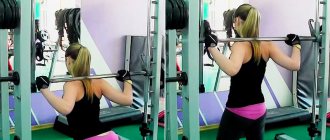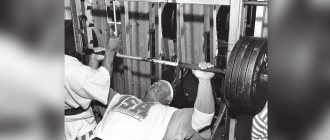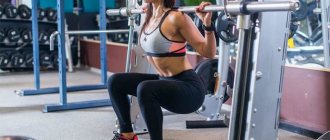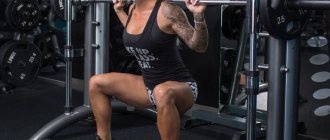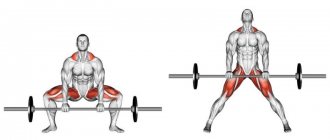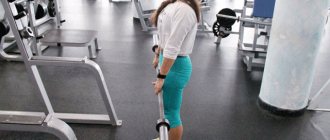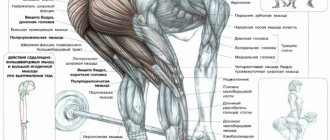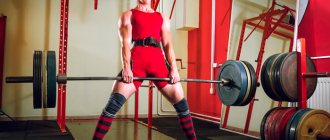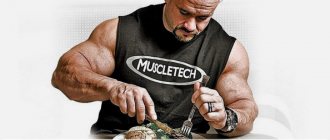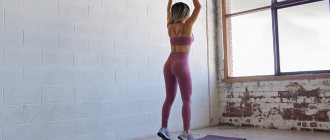Share:
What you need
- dumbbells
Every athlete or coach will agree that squats with dumbbells are a necessary exercise for gaining muscle mass. It is hardly possible to do without it. This is a basic multi-joint movement in which a huge number of muscle groups are directly or indirectly involved. And without a base there will be no growth.
You need to train your legs regularly, regardless of your sports goals. One workout per week will be enough. If it is physically and psychologically difficult for you to work out this entire muscle mass at one time, you can do quadriceps and hamstrings on different days. If you are gaining muscle mass, muscular legs will make your figure more proportional.
Moreover, heavy load on large muscle groups (and legs are such) promotes increased production of endogenous testosterone, which stimulates muscle growth and an increase in strength.
In this article we will look at how to do squats with dumbbells correctly, what are their benefits and what types of this exercise exist.
Benefits of Exercise
Let's start with what exactly the exercise is useful for athletes and what are its advantages over squats with a barbell.
- When working with dumbbells, it is easier for you to vary the angle of the load. For example, you can place your feet wide or narrow, place one foot on a bench, lift dumbbells above your head, etc. This way you can modify the load, shifting the emphasis to the quadriceps, buttocks, hamstrings or hip adductors. This is much more difficult to do with a barbell and requires experience and coordination.
- It will be easier for you to keep your back straight and squat deeper. This is the main advantage of squats with dumbbells for girls - the greater the amplitude, the more the gluteal muscles are involved, and this is the goal of most female athletes.
- The next important factor is mental attitude. Your brain perceives dumbbell squats as an easier exercise than barbell squats. Therefore, the body does not need any additional stimulation. If you are a fan of heavy training and squat almost record-breaking weights every week, vary your workouts. Do squats with dumbbells at least once a month. This way you will relieve your central nervous system a little from constantly working at the limit and protect yourself from overtraining.
- Another advantage of squats with dumbbells is that you can do them not only in the gym, but also at home. All you need is a pair of collapsible dumbbells. Do several sets of dumbbell squats with different leg positions, Bulgarian squats, lunges, straight-legged deadlifts, calf raises, and you’ll get a full-fledged volumetric leg workout.
Differences in technology for women and men
Wide squats with dumbbells for the buttocks are especially effective for women. Also, this area is perfectly worked out by such an exercise as wide squats with dumbbells in front of you in your hands. For men, to increase the definition of their legs, it is recommended to perform classic squats with different leg positions.
There are no particular differences in the technique of performing squats with dumbbells for girls and men; the difference lies only in the goal they pursue. The former most often strive to lose weight and build muscle instead of fat. And the latter want to pump up the relief, and the more, the better.
Based on this, girls are recommended to increase the frequency of repetitions, amplitude and number of approaches, without trying to conquer a lot of weight. Guys, on the other hand, should increase weight regularly and work slowly. This is the difference between cardio and strength training.
Benefits of squats
Squats with dumbbells involve a huge number of stabilizer muscles. In this case, these are the deltoid and trapezius muscles, spinal extensors, core muscles, calf muscles, neck muscles, biceps and many others. Do you understand how much load you set with just one exercise?
In addition to stabilizer muscles, ligaments and tendons are also strengthened. You become stronger and more resilient with every workout.
Squats with dumbbells place less axial load on the spine. This does not mean that it is not there at all, and if you have hernias and protrusions, you can do them every workout. Not at all. Simply working with dumbbells in a gentle manner will not aggravate existing problems, unlike barbell squats.
In addition, working with dumbbells is much more mobile. You can place dumbbells on racks and immediately pick up a lighter or heavier pair. It is much more convenient to perform dropsets, supersets and giant sets. All of these techniques for increasing intensity contribute to greater overall results.
Benefits and disadvantages of Bulgarian squats
An obvious advantage of split lunges is that this type of exercise is physically and technically difficult. Firstly, due to the elevation of the auxiliary leg, you need to maintain balance, and secondly, due to the lack of help from additional muscles. In this position, the athlete is deprived of the opportunity to help with the second leg.
advertising is not displayed
This type of lunge uses the maximum number of muscles, compared to other lunge options, due to the position of the second leg, making it impossible to distribute the load.
The disadvantage of the exercise can be considered the technical difficulty of execution. Finding a comfortable position to perform the movement and maintaining balance is extremely difficult, which can lead to falls and injuries.
A person may also experience discomfort in the ligaments. People with ankle or foot injuries may find it impossible to perform this exercise due to severe discomfort or pain in the ligaments.
Contraindications
Not all athletes will benefit from this exercise. If you have knee problems, you need to perform squats very carefully, work with light weights and strictly follow the correct technique. A thorough warm-up and use of knee bandages is also necessary. This applies not only to dumbbell squats, but also barbell squats, leg presses, lunges and other leg exercises.
It is not recommended to perform this exercise if you have problems with the spine. We are not talking about mild scoliosis or lordosis, but about serious hernias and protrusions in the thoracic or lumbar regions, when any forceful load is contraindicated. If such problems do not bother you, you can safely perform squats with dumbbells.
Other technology options
The basic technique for performing squats with dumbbells is a classic, but in addition to it, there are a large number of variations of the exercise, which are usually associated with changing the position of the hands. The squat program may include the following exercises:
- The dumbbells are placed at chest level, with the elbows looking to the sides.
- Dumbbells at shoulder level, elbows pointing straight.
- Dumbbells are located at neck level, behind the head. When performing squats in this position, not only the muscles of the buttocks and legs are used, but also the muscles of the shoulders and trapezius. To avoid injury, it is recommended to start with light weights. Before training, you should stretch your shoulder muscles. During squats, your arms should be perpendicular to the floor. The back is flat and straight.
- One dumbbell with a large weight is held with both hands in front of you.
- Using one dumbbell, holding it with both hands at chest level, squats are performed with twisting of the body.
- To better work the inner thigh muscles, using one large dumbbell located between the legs, or using two on the sides, squats are performed with a different position of the legs. To do this, the legs are placed wider than shoulder level, the toes are turned outward by 120°. When performing the exercise, the knees look to the sides. The squat is performed until the thighs are parallel to the floor. The back and shoulders remain straight and do not bend. When lifting, tighten your gluteal muscles. This type of squat is called plie. An analogue of this exercise is sumo squats, which are distinguished by tilting the back forward and moving the pelvis back during the squat. Sumo is an effective exercise.
- The exercises are performed according to the classical scheme, only at the moment of rising from a squat you need to jump up and squat down from the jump.
Squats can be performed not only with dumbbells, but also with a barbell and a bodybar. Currently, there are a variety of techniques for performing barbell squats, which are very beneficial for the muscles. But the main and widely used ones are: simple squats with a barbell, Romanian deadlifts.
Squats with a barbell for girls are performed from a position with feet shoulder-width apart, the back is straight, the toes are slightly pointed to the side, the head is slightly looking down. The barbell is placed on the bone of the shoulder blade, in no case on the neck. The bar is held from behind with your hands. Squats are performed downwards with a straight back, the pelvis is pulled back, the knees do not protrude beyond the toes. The lower the squat, the stronger the effect.
The Romanian deadlift, or straight-legged deadlift, is performed from a shoulder-width apart position, back straight, knees slightly bent, barbell in front of you, held by hands. The exercise is performed by simultaneously bending the torso forward and moving the pelvis back. The bar should not fall straight down, but slide along the thighs. The barbell should not touch the floor; it should reach the level of the shin. The exercise is performed slowly, without sudden jerks or jolts. When performing the Romanian deadlift, you need to tense the muscles of the buttocks, not the back.
What muscles work?
Depending on where exactly you place the dumbbells, what incline you hold, how wide you place your legs, and how you place your feet, you can focus the load on the quadriceps, glutes, hamstrings, or hip adductors.
For example, when doing plie squats with a dumbbell, we spread our legs wider than shoulder-width apart and turn our feet outward, and keep our body strictly vertical. This loads the inner thigh and buttocks, part of the load is taken by the quadriceps. It's the same story with wide squats with dumbbells. Such a load makes the hips larger. The inner surface of the thigh responds well to load in almost all athletes; with the outer surface, everything is much more complicated, and few even experienced athletes can boast of its development.
To develop the outer quadriceps, close-legged squats, overhead dumbbell squats, or single-leg dumbbell squats are more suitable. It is important to place your feet parallel to each other to further contract the lateral quadriceps muscle.
You can also shift the load specifically to the gluteal muscles. Bulgarian squats with dumbbells are best suited for this. The load falls almost exclusively on the buttocks; if you lean forward a little more, the hamstrings will also begin to work. The greater the amplitude in these movements, the better. Deep squats with dumbbells are great for girls.
Classic exercises
If the squats described above for the buttocks are not within your power, you should use the traditional method, specially designed for girls who do not want to subject their body to increased stress. They also allow you to pump up the muscles you need, but the effect will take a little longer to appear and will require a lot of patience from you
When performing such squats, you can also use a barbell or dumbbells, observing all the precautions that have already been mentioned earlier
From school practice
Everyone learned to do the simplest option at school during physical education classes - to do this you need to stand with your feet shoulder-width apart. Lower your arms vertically down, keep your back straight and try not to lean forward.
Correctly squat as you exhale and rise as you inhale - then your respiratory system will receive the maximum volume of vital oxygen. With the help of a similar exercise for girls, you can remove fat from the buttocks and restore their rounded shape.
Squats with feet and toes out
With your hands on your lower back, squat as deeply as possible, trying to push your buttocks back as far as possible - a small stool will again help you with this. Rise slowly to avoid straining your quadriceps femoris muscle.
With this workout you can pump up the inner thigh, which is a problem for many girls.
Technique with combined feet
These exercises help tighten your buttocks, making them a little higher. The exercise is completely similar to the first method, but you should use your hands as balancing tools, since many people lose their balance in this position.
In a similar way, it is possible to pump up the outer surface of the thigh, getting rid of unpleasant folds and sagging.
General principles of the exercise
Next we will talk about several variations of the exercise, but before moving on to a description of the technique of each type, we should mention the general principles of correct squats with dumbbells.
- Working out the inner thighs is facilitated by wide stance of the legs and turning the toes outward (more than 45 degrees).
- Working out the gluteal muscles is facilitated by the maximum possible range of motion (below the level of parallel with the floor).
- Working out the outer thigh is facilitated by a narrow and parallel stance of the legs.
- Working out the hamstrings is facilitated by a slight bend forward and moving the buttocks back during movement.
Precautionary measures
Squats with dumbbells between your legs at home are fraught with various injuries and sprains. To avoid trouble, first of all, do not use equipment that is too heavy. Start training with light dumbbells or no dumbbells at all. And only when you feel that you have developed your muscles sufficiently, increase the weight. And also adhere to the following rules:
- Do not lean on your toes while squatting. This will cause you to lose your balance. Therefore, place your center of gravity on your heels and the outer parts of your feet.
- During squats, make sure that your knees do not extend beyond your toes. In this case, the load on the joints will increase, which will lead to their abrasion.
- Keep your body straight and never slouch. Otherwise you will damage your spine.
- To avoid problems with balancing, do not point your toes out more than 30 degrees.
- Look straight ahead or slightly up. Then your back will be kept in the correct position.
- When performing squats with dumbbells between your legs, be sure to perform the exercise smoothly. Remember, sharp lunges lead to sprains and even torn ligaments.
- During exercise, keep your core muscles in static tension. Thanks to this approach, your position will become more stable, in addition, you will reduce the load on the spine and prevent injury.
Weighted squats are a great exercise to help you achieve noticeable results.
But it is important that the technique of performing the exercise is correct. In addition, do not forget that a visible effect is achieved only by regular training and alternating classes.
Types of squats with dumbbells
Let's look at several of the most effective types of squats with dumbbells.
Plie squats with dumbbells
Plie squats with dumbbells - to perform effectively, you need to hold it with both hands in front of you at waist level. Instead of a dumbbell, you can also use a kettlebell or a barbell disc. The main thing in this exercise is to maintain the correct body position.
- The dumbbell should not weigh you down or tilt you down.
- We place our feet wider than our shoulders, turn our toes outward, the angle is approximately 60 degrees.
- Keep your back strictly vertical.
It is advisable to place your feet on step platforms; this will increase the range of movement by a few precious centimeters, and you will be able to go lower. Due to this, the buttocks and hip adductors will work harder. You need to lower yourself down until you touch the back of your thigh to your calf muscles. The pace of the exercise is smooth; no sudden movements should be made. It is important to feel the stretching and contraction of the muscles at each point of the amplitude.
Bulgarian squats
The next popular leg exercise that can be performed with dumbbells is Bulgarian squats. To perform them you will need a horizontal bench. We place one foot on the bench with the toe down, and bring the other forward. The distance between the legs should not be too large; the front leg should be slightly bent at the knee. Squat down smoothly on your front leg. Anatomically, the movement is similar to lunges. The farther you place the front leg, the more the gluteal muscles work; the closer, the more the load is emphasized on the quadriceps. Beginner fitness enthusiasts are advised to adhere to a certain “golden mean”: put one leg forward so that the knee remains slightly bent, and there are still a few centimeters between the knee and the foot.
If you want to additionally “hook” the inner surface of the thigh, do not place your front leg straight, but slightly turn your toe outward. The exercise should be done with moderate weight; in no case should you round the thoracic spine when lowering down. The amplitude here may be somewhat shortened. Often athletes work in a static-dynamic mode, without going all the way down and without straightening the knee at the top point. This way, the necessary muscle group will be under constant tension, and even light dumbbells will be enough to create sufficient prerequisites for muscle growth.
Squats with dumbbells on shoulders
Squats with dumbbells on the shoulders almost completely imitate classic squats with a barbell. The load vector falls in exactly the same way. The only difference is that there is no need to statically tense almost all the muscles of the torso, as with heavy squats with a barbell. Just position the dumbbells so that you are comfortable without them weighing you down. Keep your back as straight as possible so as not to place stress on the spinal extensors.
© artinspiring — stock.adobe.com
Another option for holding dumbbells on your shoulders:
© dusanpetkovic1 — stock.adobe.com
Deep squats with dumbbells in hands
You can load the quadriceps in isolation by performing deep squats with dumbbells in your hands. The easiest way to do this is to use one dumbbell or kettlebell and hold it in front of you at chest level. The result will be an almost complete imitation of front squats with a barbell. This exercise is often called goblet squats.
Here it is advisable to use a relatively narrow parallel position of the legs. Place your feet slightly narrower than shoulder-width apart so that you can comfortably perform the exercise with a decent weight and you can fully focus on contracting your quadriceps. At the bottom point, you can take a short pause, completely extinguish the inertia and rise upward in an explosive manner. This training method develops explosive strength and speed of movement well. In the same style, you can perform squats with dumbbells in your hands, keeping your arms straight along your body. This exercise is good for developing neuromuscular communication and teaches you better control of the stabilizer muscles, which will be useful for you on record weights in barbell squats.
Single leg dumbbell squats
For experienced athletes, squats with dumbbells on one leg are also good. This exercise requires not only strength, but also tremendous coordination and balance. It should be performed at a slow pace and with light working weights. Of course, before this you need to learn how to consistently perform pistol squats without additional weight, or at least with the help of TRX loops or other support.
© Makatserchyk — stock.adobe.com
Overhead dumbbell squats
CrossFit athletes can take note of an exercise such as overhead squats with dumbbells. It is not much different from overhead squats with a barbell in terms of biomechanics, but psychologically it is much easier. These exercises are needed in order to increase your results in basic weightlifting movements: snatch, clean and jerk, clean and others. Here you can give yourself free rein and work with heavy weights, but remember that the correct technique for performing the exercise is above all.
© Arsenii — stock.adobe.com
Alternatively, you can perform this variation of the movement with two dumbbells:
Scissor squats with dumbbells
Dumbbell scissor squats are a variation of lunges. They are especially popular among girls. They are done in exactly the same way as Bulgarian squats, only without using a bench. To increase the range of movement, you can place one or two step platforms under your front leg. This way you can go down as low as possible and fully bend your front leg at the knee joint. This way the quadriceps will do more work than when performing movements at half the amplitude.
CrossFit complexes containing lunges with dumbbells
The functional complexes given below contain lunges with dumbbells and will not only contribute to the complex development of the athlete (strength, endurance, coordination, muscle mass gain, etc.), but will also significantly increase your energy expenditure during training.
Don’t forget to eat right and recover, since this is what determines whether you can show a truly champion result today. If you feel unwell of any kind, lack sleep, or simply feel not at your best, we recommend holding off on these complexes until you have fully recovered your strength and replace them with something easier.
| Chicken Legs | Perform 30 dumbbell forward lunges, 10 classic barbell squats, 10 front squats, 10 overhead squats. Only 3 rounds. |
| Heavy Metal Maniac | Perform 6 deadlifts, 10 pull-ups, 20 side lunges, 20 forward lunges, 20 burpees. Only 5 rounds. |
| Hamstrings Boom! | Perform 20 forward lunges, 5 stiff-legged deadlifts, 20 Bulgarian lunges, 5 straight-legged deadlifts, 20 box step-ups, 5 straight-legged deadlifts. |
| Exactly | Perform 6 barbell thrusters, 8 deadlifts, 30 dumbbell forward lunges. Only 5 rounds. |
| Quadzilla | Perform 10 front squats, 20 forward lunges, 10 spring jumps, 20 forward lunges, 10 classic squats, 20 forward lunges, 10 box steps, 20 forward lunges. Only 3 rounds. |
| Carina | Complete a 400m sprint, 15 overhead squats, 15 box jumps, 50 forward lunges. Only 5 rounds. |
Exercises on the topic
Bulgarian lunges
Lunges with a barbell to the sides
Lunges with a barbell on the shoulders
Author
Training experience – more than 8 years. Winner and medalist of All-Russian powerlifting and deadlift tournaments. Candidate for Master of Sports in deadlift.
Basic exercise technique
So, we briefly examined the main types of squats with dumbbells. The same technical principles apply to all of them:
- We use moderate weight dumbbells. Do you want to set records? Place them in barbell squats. We need squats with dumbbells in order to relieve the psyche a little from heavy weights, diversify the training process and give the muscles an unusual load to which they are not yet adapted. Also, many powerlifters use them as an aid to classic squats, and this bears fruit.
- In all exercises you need to keep your back straight. Rounding the spine is unacceptable; this can result in serious injury. At the starting point, stand straight, look forward or slightly upward (this will make it easier for you to get up from the lowest point). We bring the chest forward and up. The downward movement is carried out while inhaling, it is advisable to do it slowly to feel how the muscles stretch.
- Squats should be deep. It is advisable to squat below parallel. Ideally, your buttocks almost reach the floor. This requires good coordination and flexibility. Additionally, hone these skills, then any exercise will be much easier.
- At the lowest point, the knee should not go forward beyond the level of the toe. This is the golden rule of any type of squat.
- The positive phase of the amplitude passes approximately twice as fast as the negative one. We always get up while exhaling. If you do not follow the correct breathing sequence, by the end of the set your blood pressure will rise, and it will take at least a couple of minutes to regain your breathing.
- The most important thing when standing up is to keep your knee in the correct position. It should be located in the same plane as the foot. Do not wrap it inward under any circumstances; it is very easy to injure the knee ligaments this way. A slight outward movement of the knee is acceptable, but it is better not to do this either, as this will make it more difficult for you to concentrate on the work of the leg muscles.
- The pause at the top should not be too long. Firstly, the axial load on the spine at this moment is maximum. Secondly, when you just stand straight with your knees straight, the muscles are in a relaxed state. Pumping is much more difficult to achieve this way. It is advisable not to pause at the top point at all or not to fully extend the knee in order to maintain constant tension in the muscles.
- If you perform squats with dumbbells with straight arms, use wrist straps if necessary. This will take your mind off the grip and allow you to fully focus on your quadriceps.
- Always warm up and stretch thoroughly before performing dumbbell squats. This way you are guaranteed to protect yourself from injury.
Common execution errors
The technical version of squats with dumbbells in your hands is much simpler than the version with a barbell on your shoulders. Therefore, acquaintance with this movement often begins with the dumbbell version.
However, execution errors occur here too.
Using dumbbells that are too heavy
One of the most common mistakes, especially among men.
The main criterion for correctly selected weights is the ideal movement technique, with full muscle control and feeling of the working leg muscles.
Rounding the back
This is not only a common but also a dangerous mistake.
Rounding the back leads to a sharp increase in the compression load on the spine (especially in the lumbar region).
During squats, dumbbells are held in arms extended downwards. As a result, the burden is located below the center of gravity, so the load on the spine is minimal.
This exercise can be performed even by people with back problems, while working with a barbell is contraindicated for them, as it provokes a negative load on the spine.
But all this is subject to the correct technique, the criterion of which is maintaining a straight back throughout the entire movement.
Lifting your heels off the floor and leaning your body forward
This is a common mistake that can be easily corrected by placing small discs from a barbell (2.5-5 kg) under the heels. The main thing is that the thickness of the “pancake” is about 2-3 cm.
This little trick allows you to avoid lifting your heels off the floor and the closely associated tilt of the body forward.
A slight forward lean of the torso during squats is normal. But when the body leans too much, this leads to a redistribution of the force load when lifting from the legs to the lower back.
The position of the body must be monitored throughout the movement, especially towards the end of the exercise.
By this time, the leg muscles are already tired and try to help themselves with other, less tired parts of the body. As a result of such an error, the load on the legs is significantly reduced.
Now you know exactly how to squat with dumbbells correctly, and what main points you need to avoid.
Number of approaches and training program
The average recommended number of dumbbell squats for men is 10-15 repetitions of three to four sets with a dumbbell weight of 8-15 kg.
The number of squats for women is 10-15 repetitions of three to four sets with dumbbells weighing 3-5 kg.
However, the number of repetitions and approaches will primarily depend on the goal and the desired effect. If the goal is to gain muscle mass or tone muscles, then limit yourself to 8-10 repetitions in one approach. If the main goal is weight loss and toned buttocks, then do 15 - 30 repetitions. You should start with two or three approaches, gradually working up to three to five.
If your goal is to develop your legs, then an excellent option would be to combine squats with a relatively heavy barbell placed on your shoulders (five sets of five repetitions) with deep squats with dumbbells in your hands (five sets of 20 repetitions) in one workout.
Contraindications
Contraindications include:
- lower back pain;
- varicose veins on the legs.
With caution, it is necessary to include a dumbbell version in the program for those who have a history of:
- hernia or protrusion;
- osteochondrosis.
